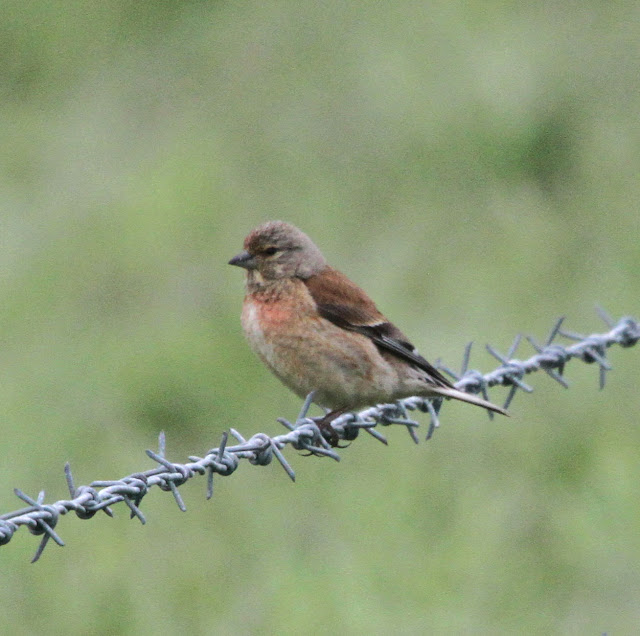On Friday the am group got to partake in a more negative side of twitching. We met at Hornsea Mere half an hour later than normal to avoid the wet start to the day. This turned out to be a good move as both sessions avoided the downpours – the afternoon session by only a couple of minutes.
Unfortunately, in the aftermath of heavy overnight rain and strong winds, there was no sign of the Roller. It had been replaced by noisy jets - not really an adequate substitute. While we scanned the area there were no hirundines over the crop this time, and although I could hear Yellow wagtails from time to time, there was only one quick glimpse. The Skylarks put on a better show, and the Whitethroat still seemed very vocal in the car park. On the return trip David noticed a Barn Owl perched on a road sign – one of the best sightings of the morning. Back at the Mere there was no sign of the Red-Crested Pochards, and very few other birds of interest. There seemed an absolute plague of Canada Geese, which appear to be taking over the site. Even their goslings had already lost that air of cuteness, which they exude in their first few weeks of life.
Linnet [male]
Bristling with Missiles
Treecreeper
At the woodland site the Treecreeper was the star performer with excellent views of 2 birds, but especially of one confiding individual. Someone (Peter?) spotted a Buzzard soaring over the hall, and we also heard a noisy Great Spotted Woodpecker, which then flew off erratically. A pair of Red-legged Partridge rocketed up, and flew away from us & hurdled a hedge into the distance. We reached a gate, which represented the furthest extent of our walk. On Wednesday we could just hear a Cuckoo at this point, but today we couldn’t hear anything interesting, and it all seemed rather disappointing, until Jeanette turned spotted a Fox carrying a dead Rabbit. We spun round but at the same time the very bright Fox saw us, and he quickly bolted back the way he had come and disappeared into the woodland.
Treecreeper
Pair of Linnets
ditto
A less red dry perched Linnet
In the afternoon we couldn’t find anything of interest at the mere, so we checked out a reserve we’ve never visited before. Even before we left the car park we came across a pair of bright Linnets and a Tree Sparrow having a bath in a puddle. We negotiated our way along the rather confusing start and blind turns among the rather recently-planted native tree species. A Swallow twittered away on an old farm building, but it wasn’t possible to snatch a picture, while a Blue Tit scolded us from a hedge. In a marshy area on adjacent land, Jim spotted a Lapwing sat on a nest. As we neared the sea the air was full of birdsong. This was made up of Skylarks, Meadow Pipits, Linnets and Reed Buntings, while large numbers of Sand Martins flitted & twittered over the long wet grass, and hung round a WWII pill-box. All but the Skylarks also sat prominently on either posts or the barbed wire. The best sight of the afternoon was seen on the return journey came when Sue W identified a Yellow Wagtail on the barbed wire. Thunder rumbled all around us with lightning flashes appearing to hit the Driffield area. One Linnet was the reddest Linnet I’d ever seen, and I even had to double-check it wasn’t a Rosefinch – it wasn’t! There was a whole family of young meadow Pipits – seemingly at least 6 juveniles – sharing their time between the wires and the mowed path, but they were flighty & it wasn’t possible to get pictures of any of them. A Willow warbler gave even briefer views as it took refuge in one of the small trees, and a Chaffinch and a flock of Starlings were the final birds we encountered. We didn’t hang around too long as eventually the ominous sky looked as though it was actually going to engulf us after all. We were just changing out of our boots and back into our shoes when the heavens opened.
Meadow Pipit
ditto
An apparently intact fossilised Tree (elm?) on the cliff edge & now open to the sea with several feet of boulder clay above it











No comments:
Post a Comment